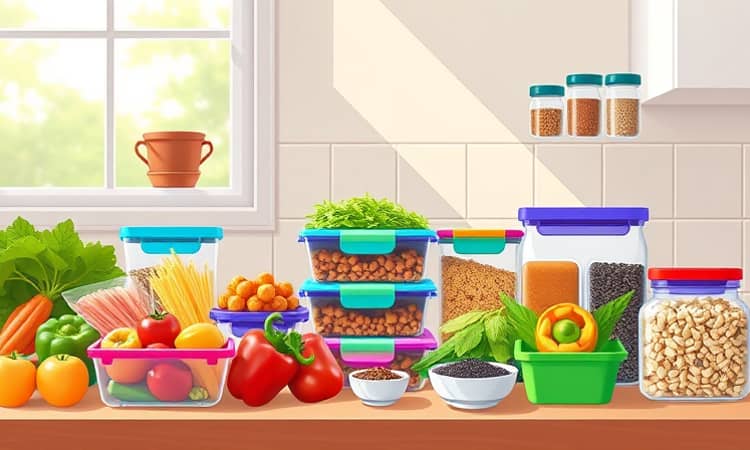Budget constraints can make meal planning feel like a daunting puzzle, forcing many to rely on expensive takeout or convenience foods. However, with a few simple strategies and a touch of creativity, anyone can transform your kitchen into a hub of affordable, nutritious meals.
Embracing a systematic approach to grocery shopping and meal prep not only helps you stretch every dollar but also fosters a deeper appreciation for the food you prepare. The sense of accomplishment that comes from crafting wholesome dishes on a tight budget can be surprisingly empowering, turning routine tasks into opportunities for growth and wellness.
Meal Planning Fundamentals
Creating a solid meal plan is the cornerstone of any money-saving strategy. Before you head to the store, it pays off to conduct an inventory check and plan weekly meals in advance to control spending.
By taking time to assess what you already have, you can prevent duplicate purchases and food waste and make the most of every ingredient, ensuring nothing goes unused.
- Inventory check: note what’s already on hand
- Menu creation: decide meals before shopping
- Weekly overview: balance nutrition and budget
Consider theme nights—like Meatless Mondays or Taco Tuesdays—to streamline decision-making and add fun to your week. Mapping out breakfasts and lunches alongside dinners ensures every meal contributes to savings and prevents mid-day splurges.
Grocery Shopping Strategies
Once your plan is ready, you can approach the grocery store with confidence. Always shop with a detailed list built around your menu and pantry check to stay focused and avoid impromptu buys.
When possible, purchase non-perishable or freezable items like rice, beans, or bread in bulk to lock in savings, as long as you will use them before they expire.
- Compare weekly ads and promotions
- Use coupons and store loyalty programs
- Buy in bulk when items are on sale
Don’t overlook digital coupons and cash-back apps that reward you for purchasing everyday staples. Scanning codes directly from your phone or syncing your loyalty card automatically can uncover hidden discounts that you might otherwise miss.
Low-Cost Meal Ideas and Ingredients
Focusing on cost-effective ingredients helps stretch your budget. Opt to switch to store brands for essentials like rice and pasta, saving up to 30% on common staples.
- Staples: rice, pasta, potatoes, legumes
- Protein: eggs, canned tuna, beans, lentils
- Produce: frozen vegetables, seasonal fruits
For those looking to diversify their diet on a budget, introducing new spices or herbs can make a big difference. Cumin, paprika, or dried oregano cost pennies per use and can transform a simple lentil soup or roasted vegetables into something special.
Meal Prep and Cooking Tips
Batch cooking and prep can transform your kitchen routine. With cooking larger portions saves time and reduces midweek stress, you’ll find that meal prep becomes a rewarding weekly ritual.
Prepare grains, proteins, and sauces on a single day. Store them in clear containers for easy access and label each with dates to maintain freshness.
Investing in basic storage containers and freezer bags will streamline your prep process and keep ingredients fresher longer. Labeling containers with dates and contents can save guesswork and ensure you enjoy meals at their peak quality.
Sample Budget Meal Plans and Costs
Understanding the actual costs of meals can motivate you to stay on track. Below is a table featuring some popular budget dishes and their benefits.
Batch Cooking & Meal Prep Benefits
Consistent meal prep delivers reduce buying expensive perishable items and keeps meals ready to heat and eat. This practice also leads to reduced stress and more free time during busy weekdays.
Many home cooks report feeling less overwhelmed knowing a healthy meal is just minutes away. This routine nurtures better eating habits, as you’re more likely to stick to planned meals than succumb to fast food cravings.
Additional Budget-Friendly Shopping and Cooking Tips
Explore substitute ingredients for premium items—using Greek yogurt in place of sour cream or oats instead of breadcrumbs can cut costs without sacrificing texture.
Explore local farmers’ markets at closing time, when vendors often discount produce significantly. Community-supported agriculture (CSA) subscriptions can also offer seasonal boxes at a fraction of supermarket prices if you plan to use everything provided.
Finally, maintain flexibility. If your favorite brand is too expensive this week, try a different vendor or an off-brand. Small switches over time can lead to significant savings.
Conclusion
Effective meal planning is more than just a shopping routine; it’s a mindset that empowers you to control your expenses, improve nutrition, and reduce waste. By combining strategic shopping habits with simple meal prep techniques, you can consistently craft delicious dishes without overspending.
Remember, every small decision—from choosing frozen spinach over fresh to resealing bulk grains—accumulates into substantial savings over the course of a year. With patience and persistence, budget-friendly meal planning becomes second nature, leading to healthier eating and a healthier bank account.
References
- https://www.myplate.gov/eat-healthy/healthy-eating-budget/make-plan
- https://www.goodnes.com/blog/meal-planning-tips-on-a-budget/
- https://www.allrecipes.com/50-dollar-grocery-budget-and-dinners-for-one-week-8549649
- https://www.unlockfood.ca/en/Articles/Budget/10-Tips-for-Planning-Meals-on-a-Budget.aspx
- https://www.juliapacheco.com/extreme-budget-meal-plan/
- https://skyterraya.com/meal-planning-101-on-a-budget/
- https://mcpress.mayoclinic.org/nutrition-fitness/meal-planning-on-a-budget-plan-purchase-prepare/
- https://www.budgetbytes.com/category/extra-bytes/budget-friendly-meal-prep/














